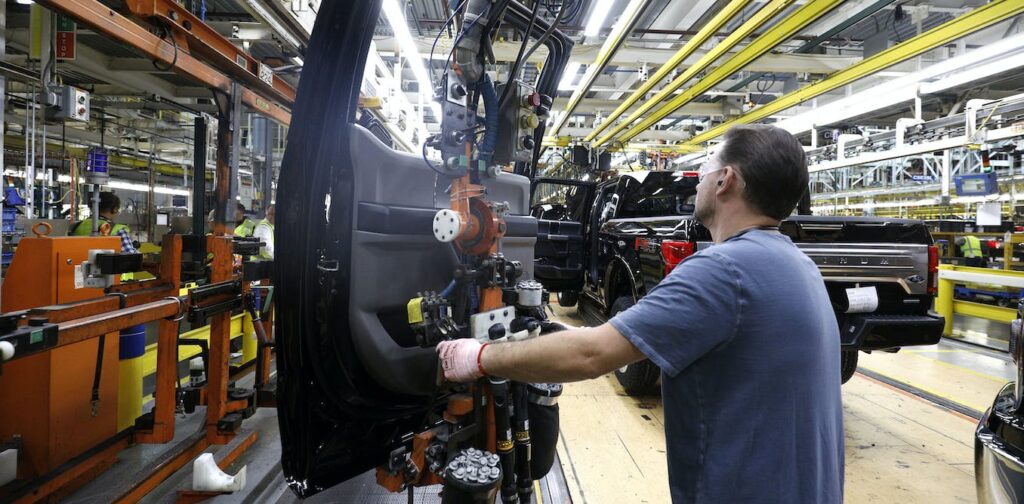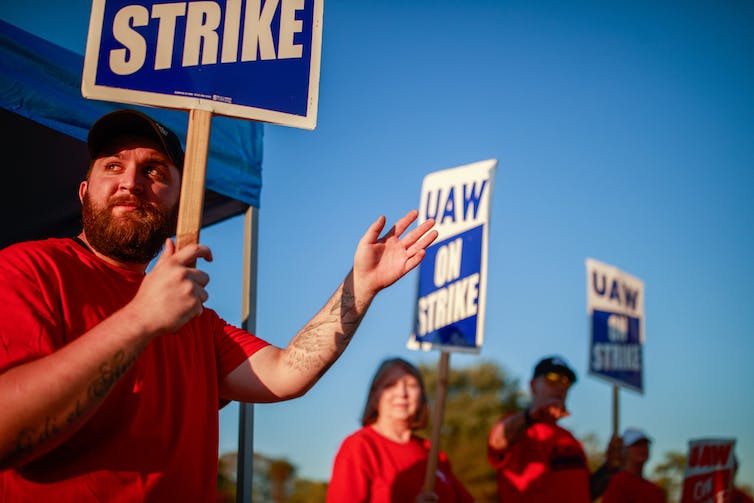Runoff vote count starts in historic UAW election – it’s already bringing profound union leadership changes and chances of more strikes and higher car prices

Ballot counting is underway this week in a runoff election to decide who will lead the powerful United Auto Workers union as its president. But the historic election is already transforming the union’s leadership in ways that could bring an end to decades of declining blue-collar compensation in this key sector of the economy.
This was the first direct leadership election in the UAW’s 88-year history, following a series of corruption scandals that sent two former presidents to prison. With most of the other leadership races already counted, it’s clear that the union’s leadership will be closely divided between the old guard and the challengers.
This transformation of how the UAW is governed sets up what is widely expected to be a more adversarial relationship between the union and the Big Three domestic car producers. Regardless of who wins the presidency, a more combative stance with automakers is likely to result in more strikes, higher car prices and also greater competitive pressure on domestic companies to outsource or challenge unionization at new plants opening to make electric vehicles and their components.
I have written about trade unions in the United States and Europe for over three decades. My latest book is “The UAW’s Southern Gamble: Organizing Workers at Foreign-owned Vehicle Plants.” The direct elections, while making the UAW better reflect the interests of workers, will challenge companies at the same time the Biden administration is trying to revive manufacturing and boost union influence. The results could reverberate through the nation’s fragile economy.
How a scandal gave workers more power
The UAW held a first round of direct elections for the union’s president and leadership board in late 2022, with ballots mailed to working members and retirees.
This new election format is a product of a 2021 consent decree between the UAW and the Justice Department to settle a sprawling corruption scandal in which several top union officials were convicted of taking bribes from the auto companies and spending millions of dollars of union funds intended for worker training on luxuries for themselves, including trips and a Ferrari.
During the campaign, the incumbents, led by current UAW president Ray Curry, have depicted their slate as a safer and more experienced set of hands, which would be particularly valuable in troubled economic times. The challengers, led by Shawn Fain, have accused incumbents of conceding too readily to management, tolerating a culture of patronage and scandal and failing to practice democracy. Curry was never implicated in the scandal.
UAW President Ray Curry, center, flanked by Michigan Gov. Gretchen Whitmer and Ford Motor Co. President and CEO Jim Farley, spoke on Feb. 13, 2023, after Ford announced plans for a new electric vehicle battery plant in Michigan.
AP Photo/Carlos Osorio
For decades, UAW leaders were chosen through an indirect process common to many unions. Delegates to the UAW convention chose top officers, and regional conventions picked regional directors.
This system was raucous in the union’s early days. Ferocious struggles among communist, socialist and voluntarist factions at UAW conventions rocked the union in the 1930s and 1940s until the socialists under the leadership of Walter Reuther prevailed. Reuther consolidated power through an internal group, which eventually became known as the Reuther Administrative Caucus, or RAC, and came to dominate UAW conventions. Joining and adhering to the positions of the RAC was a prerequisite to advancement within the union.
Critics compared the RAC to a one-party state. Union dissidents accused the RAC’s leaders of being too quick to crush dissent and to make concessions to the auto companies. Ultimately, the dominance of the RAC left the UAW vulnerable to scandal, which is why the consent decree mandated a referendum to decide whether to have direct elections of top union officers. Union members voted in favor.
Two sides quickly formed in the lead-up to direct elections for the UAW’s top governing body, the International Executive Board: the Curry Solidarity Team, which was the informal successor to the Reuther Administrative Caucus, and challengers who called themselves UAW Members United. The challengers blame the incumbent leadership for a much-hated two-tier wage structure that compensates new hires at a lower rate and say the incumbents haven’t done enough to secure jobs in the transition to electric vehicles. The incumbents say the challengers are armchair critics without answers to tough problems.
The UAW Members United group exceeded expectations in the December 2022 elections, winning five of the 14 International Executive Board seats, including two of three vice-president posts and the secretary-treasurer, the second-highest position in the union. The Curry Solidarity Team won six seats, an independent won a seat, and the runoff will decide the winner of the presidency and one district head.
Expect internal conflict
Bringing together an International Executive Board that is evenly divided between the two slates will be a challenge regardless of who wins the presidency.
Direct elections will make it far more difficult for the UAW leadership to agree to difficult trade-offs between decent compensation and job security on the one hand and preserving the competitiveness of the domestic auto producers on the other, because dissatisfied members can now challenge leaders through direct elections.
Being elected to a top position in the UAW is now much more like running for Congress. Candidates need to appeal to base voters and take positions that can feed polarization. Top union officers will have less room to deviate from campaign promises because direct elections make it far easier to challenge them.

The UAW in February 2023 increased strike pay from $400 to $500 a week. A more aggressive union could mean more strikes like this one, at a plant in Indiana.
Jeremy Hogan/SOPA Images/LightRocket via Getty Images
Having a sharply divided leadership board could also make union policies less coherent and lead to internal paralysis, which would be disastrous for not only the union but also for companies with union contracts. Union members vote to ratify all contracts, and a dispute could make ratification less likely. It would also be harder for a union with a leadership riven with strife to organize new workplaces.
Both camps within the UAW recognize the grave risks of internal division and have been careful so far to remain civil. It is an open question, however, whether mutual accommodation is durable given the intense views of many rank-and-file members.
What will the election mean for negotiations?
The first major test of the new UAW will be this fall’s collective bargaining negotiations with the Big Three: Ford, General Motors and Stellantis, which includes Chrysler.
Both factions agree on opening demands: the restoration of cost-of-living adjustments to the new contract and the elimination of the two-tier wage system. It is too soon to tell whether they will turn on each other in the heat of negotiations.
One thing is certain, however: The UAW’s experiment with more direct democracy will shake both the auto industry and the economy, as it permits a much less mediated expression of worker concerns – replete with contradictions and disagreements – to come to the fore. As newly elected UAW Secretary-Treasurer Margaret Mock put it, “the companies should prepare for a new, more aggressive UAW.”
This article was updated March 1, 2023, with the runoff vote count beginning.




